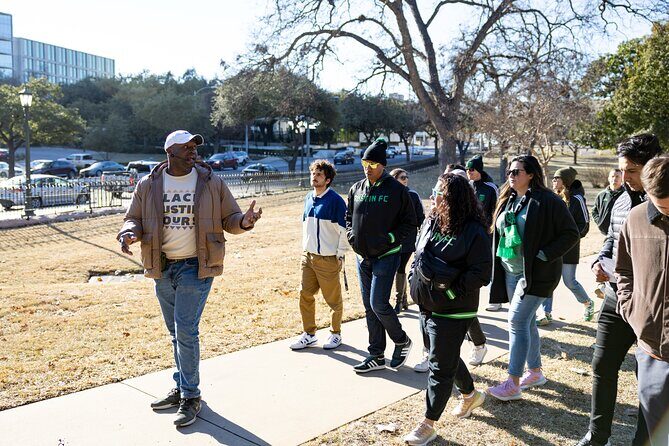Physical Address
304 North Cardinal St.
Dorchester Center, MA 02124
Physical Address
304 North Cardinal St.
Dorchester Center, MA 02124

Explore Austin’s Black history with a 2-hour walking tour through downtown, visiting landmarks, discussing civil rights, and uncovering stories seldom told.
Discover Austin’s Black history through an engaging 2-hour walking tour that takes you past influential landmarks and stories often overlooked. This tour offers a deep dive into the vital contributions of Black people to the city’s development, from its founding days through the civil rights movement and beyond. Led by knowledgeable guides, it’s a chance to see Austin’s historic heart through a different lens, shedding light on stories of resilience, commerce, and activism.
One aspect we particularly appreciate is how this tour balances historical facts with meaningful discussion. It’s not just about seeing sights; it’s about understanding the significance behind them. That said, it’s a walking tour, so comfortable shoes and a little stamina are recommended. The tour’s length and scope make it perfect for anyone interested in authentic, educational experiences that go beyond typical sightseeing.
If you’re passionate about history, civil rights, or simply want to connect with Austin’s often-hidden stories, this tour is a great fit. It’s especially suited for curious travelers who appreciate context and storytelling, as well as those wanting to see downtown Austin from a fresh perspective.


This tour, priced at $55 per person, is designed to give an honest, respectful look at a vital part of Austin’s story. As you walk through the streets downtown, you’ll see that this experience is more than just sightseeing; it’s an invitation to reflect on the contributions, struggles, and resilience of Black Austinites over centuries.
History buffs will find these Austin heritage tours enlightening
Your journey begins at the Texas African American History Memorial, located on the Texas State Capitol Grounds. Here, you’ll get a broad overview of African American history in Texas, from Spanish colonial times through recent years. The memorial itself acts as a powerful visual anchor, highlighting the often-unseen labor that built many of Texas’s grandest structures — notably, many Black incarcerated men and women were forced into convict leasing to help with construction, including the Capitol.
This site sets a serious, contemplative tone for the tour. One reviewer appreciated how the guide contextualized Texas African history within the broader story of Austin’s rise as a cotton hub. The 30-minute stop is free, making it a perfect introduction to what’s ahead.
Next, the tour takes you to the Texas Governor’s Mansion, where discussions center around the history of slavery in Austin and Travis County. Here, the guide humanizes those who were enslaved, giving face to the names and stories often left out of mainstream history. The mansion, completed in the late 19th century, was built during a time when slavery and forced labor shaped its construction.
A visitor remarked how this stop made the history feel more tangible, emphasizing stories of individuals rather than abstract facts. With 15 minutes allotted, it’s a concise yet impactful moment.
Wooldridge Square is a visit to one of Austin’s original four squares, dating back to the city’s planning in 1839. Over time, it became a hub for Black churches, schools, and social institutions. Booker T. Washington’s speech here in 1911 underscored the importance of education and community resilience.
Walking here, you can visualize the early Black community’s efforts to establish a sense of place and identity amidst adversity. The guide discusses how Black Austinites actively contributed to the city’s growth, even as they faced displacement and segregation.
This courthouse, adjacent to Wooldridge Square, has deep civil rights significance. The landmark 1946 case — Sweatt v. Painter — challenged racial segregation when Texas refused Black applicant Heman Marion Sweatt admission to the University of Texas Law School. Thurgood Marshall argued this case in Austin, highlighting the fight against Jim Crow laws.
A review mentions how the guide explained the case’s importance in the broader civil rights movement, illustrating how local struggles fueled national change. The stop lasts about 15 minutes and is a core part of understanding Austin’s civil rights history.
If you enjoy exploring Austin on foot, these walking tours might also suit your style
Walking down Congress Avenue, the tour highlights the Paramount Theatre’s role in desegregation efforts. It was a site where protests and sit-ins helped push for equal rights in public spaces, including the famous swim-ins at Barton Springs and protests against segregation in public transit.
One reviewer appreciated how the guide connected historical protests to ongoing struggles for equality, making history feel relevant. This stop also provides a window into Austin’s cultural shifts in the 20th century.
The tour wraps up on East Sixth Street, once the thriving commercial hub for Black residents. Before the 1928 creation of the Negro District, Black entrepreneurs and patrons thrived downtown. Post-displacement, many moved east, where Black businesses continued to serve as vital community anchors.
A reviewer noted that understanding the displacement and resilience of Black business owners added depth to the tour. You’ll end with a broader picture of how economic and social forces shaped Black life and business in Austin.

The tour is a walking exploration covering approximately one mile over two hours, including time for discussion at each stop. Most sites are free to visit, apart from any optional tips or personal purchases. It’s suitable for most travelers, with service animals allowed and near public transportation.
For $55, the experience offers solid value, especially considering the depth of storytelling and access to landmarks that aren’t usually open for in-depth exploration. The guide’s insights, combined with the historical significance of the stops, make it a meaningful addition to any Austin itinerary—particularly for those with an interest in civil rights, African American history, or local culture.
The tour’s structure encourages dialogue about race, community, and resilience, which makes it particularly engaging for those who enjoy learning through conversation and reflection.
This walk resonates most with history buffs, civil rights advocates, and culturally curious travelers. If you’re keen on understanding Austin’s complex past beyond the usual tourist sights, this tour provides the context and stories that bring the city’s evolution into sharper focus. It’s also suitable for educators, students, or anyone interested in social justice issues.
While the tour is accessible most people, those with limited mobility may find some parts challenging, given it’s primarily a walking experience. Still, the manageable length and engaging stops make it a worthwhile journey into Austin’s often-unseen past.

For travelers looking to connect with Austin beyond the bright lights and live music, this Downtown Black History Walk offers a rare, meaningful perspective. It’s a well-paced, informative experience that sheds light on stories of perseverance and community that helped shape the city.
You’ll appreciate the way the tour balances historical facts with personal stories, bringing historical figures and struggles into focus. Whether you’re visiting Austin for a weekend or seeking to deepen your understanding of the city’s past, this tour stands out as a compelling and affordable way to learn. It’s best suited for those who love authentic, story-driven experiences and are eager to see Austin through a different lens.

How long is the tour?
The tour lasts approximately 2 hours, covering about one mile on foot.
What is the start and end point?
It begins at the Texas African American History Memorial and ends near the Driskill Hotel at 6th Street & Brazos.
Is the tour suitable for children?
Most travelers can participate; however, since it’s a walking tour with historical content, younger children might need extra engagement or breaks.
Are tickets included?
All fees and taxes are included in the $55 price; most stops are free.
Can I cancel my reservation?
Yes, you can cancel up to 24 hours in advance for a full refund.
Are service animals allowed?
Yes, service animals are permitted throughout the tour.
Will I need to bring water?
Bottled water is not included, so it’s advisable to bring some for hydration.
How do I book?
Reservations are typically made up to 21 days in advance, and mobile tickets are provided for easy access.
Is the tour accessible by public transportation?
Yes, it is near public transit options, making it easy to reach the start point.
What makes this tour different from other Austin sightseeing options?
It focuses specifically on Black history and civil rights, providing meaningful stories that aren’t usually part of standard city tours.
In all, this tour offers a respectful, eye-opening look at Austin’s past, perfect for travelers wanting to understand the city in a richer, more complex way.